Could Worms Be Hiding in Your Dog's Gut Without You Knowing?
It can be challenging to tell if your pet may be infected with roundworms, tapeworms, hookworms or whipworms. In fact, by the time you actually see a worm in your dog's stool, he's likely overrun with them. Any of these four signs can be a tell-tale clue that your dog may be infected.
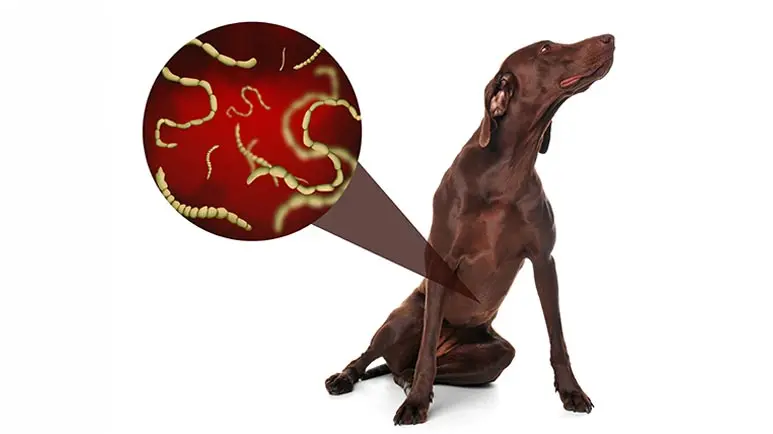
STORY AT-A-GLANCE
- Intestinal worms are relatively common in dogs; four of the most common include roundworms, tapeworms, hookworms, and whipworms
- Common symptoms in canine worm infestations include diarrhea, vomiting, weight loss, and poor coat condition
- If you think your dog might have worms, prompt diagnosis and treatment will assure the best outcome
- Treatment should be targeted to the specific identified parasite; combination dewormers, especially those given monthly, should be avoided
Editor's Note: This article is a reprint. It was originally published September 1, 2023.
If you’re a dog parent, you’ve probably experienced an intestinal worm infestation or two in your canine family members. If not, consider yourself lucky and remember, never say never! Countless dog owners have been shocked to learn worms have taken up residence in their pet’s digestive tract and often, it’s a complete mystery as to where or how they acquired them.
If you’ve been caught by surprise by an infestation in the past, one mistake you might have made was assuming no worms existed because you hadn’t seen any. However, most worms are so small they aren’t visible to the human eye (except for roundworms and tapeworms, in some instances), which is why a fecal exam is needed. Your veterinarian will perform a special test or examine the sample under a microscope to check for parasitic invaders.
There are several types of worms that can wriggle their way into your dog’s gastrointestinal (GI) tract, among them are roundworms, tapeworms, hookworms, and whipworms.
Roundworms
Roundworms are large and resemble spaghetti. They can create a full-blown infestation in your pet before you even know they’re onboard.
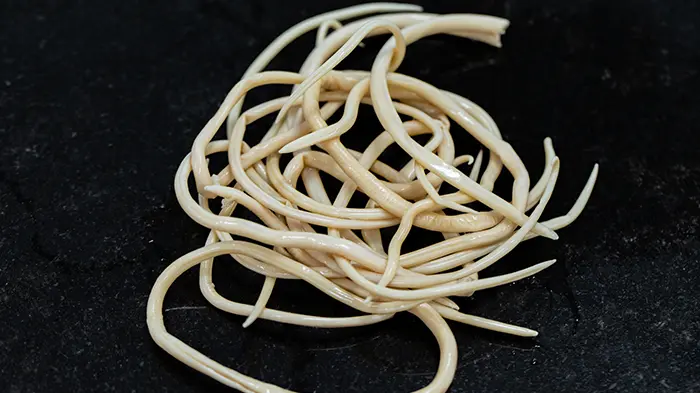
By the time you see signs of roundworms in your dog’s poop or vomit, he’s overrun with them, which is why it’s important not to wait until you actually see the worms to alert you to an infestation. If you suspect your dog has been exposed, you should collect a stool sample and drop it by your veterinarian’s office for analysis.
Pets typically acquire roundworms by eating infected feces. The infection can also be passed from a female to her unborn litter across the placenta. The pups develop their own infection while still in the uterus and are born positive for roundworm. Puppies with roundworm often have potbellies and poor growth. If not treated quickly, a severe infestation can block the intestines and cause death. That’s why you should check fecal samples at 6, 8, 10 and 12 weeks.
Tapeworms
Tapeworms are flat-shaped, with a head, neck, and many body segments called proglottids. The head has suckers and hooks that allow the tapeworm to deeply embed into the walls of the small intestine.
The worms can range from under an inch to several feet (yes, feet!) in length. Tapeworm segments are often seen near the anus of an infected pet, and segments that have been recently passed out of the body may still be moving.
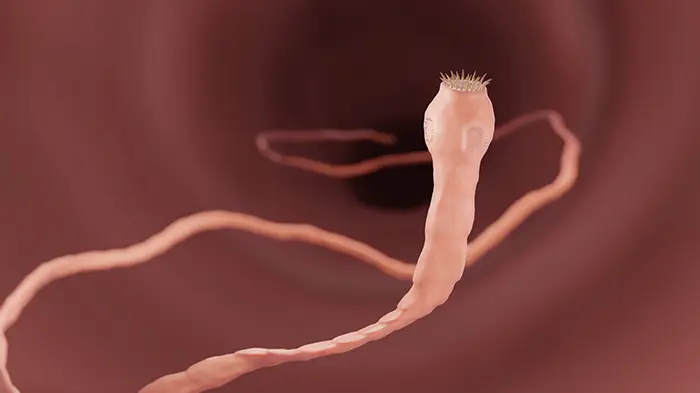
Your dog can acquire a tapeworm infestation by eating part or all of an intermediate host (e.g., birds, fish, reptiles and rats) carrying tapeworm eggs, larvae or cysts. Fleas and lice also harbor tapeworm eggs. The most common method of transmission is through ingestion of adult fleas, birds, rodents, rabbits or through scavenging.
Free-roaming pets with access to freshly killed wild or domestic animals are at increased risk of acquiring tapeworms, as are animals with heavy lice and/or flea infestations.
Pets with tapeworms often show no signs of discomfort. When symptoms do occur, they can include itchiness around the anus, licking of the anal and perianal area, scooting, weight loss without loss of appetite, increased appetite without weight gain, poor coat or skin condition, distended or painful abdomen, diarrhea, lethargy, and irritability.
Rarely, a heavy infestation of adult tapeworms causes partial or complete intestinal blockage, which is a true medical emergency. These parasites can be difficult to diagnose, and sometimes the only noticeable symptom is what looks like grains of white rice (tapeworm segments) stuck to or crawling through the fur around a pet’s rear end.
Hookworms
Hookworms attach to the intestinal wall and suck the blood of the host. They are pale grey or slightly pink in color, and the head (at the front of the body) is bent a bit in relation to the rest of the body, forming a hook shape.
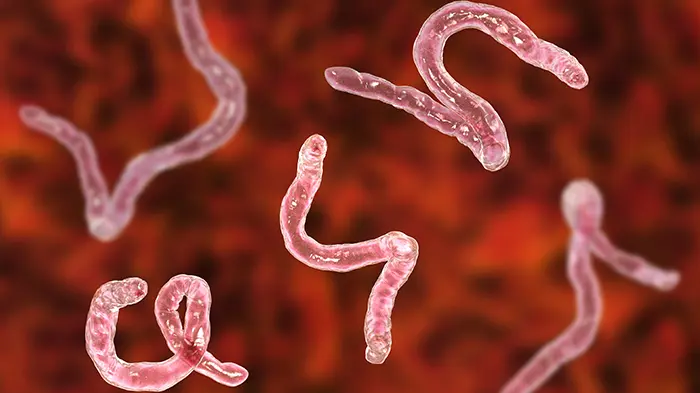
They’re primarily transmitted fecal-orally to animals, meaning your dog may eat contaminated feces or dirt, or he might walk through contaminated soil, then lick his paws and ingest the eggs.
Puppies can acquire hookworm from an infected mother’s milk and become lethargic, weak, malnourished and anemic. It isn’t uncommon for young pets to die from a hookworm infestation. Infected adult pets may show symptoms of poor appetite and weight loss. Chronic hookworm infestation is a common cause of illness in older dogs.
Humans can also acquire a hookworm infection, typically by picking up the eggs or larvae on the skin from soil contaminated by infected wild animal or pet poop. Hookworm larvae can penetrate human skin, and they aren’t visible to the naked eye.
To prevent a hookworm infestation, it’s important to get rid of any potentially infective feces from wild or stray animals around your property that might tempt your dog. It’s also a good idea to keep your pet away from the poop of other animals while you’re walking outdoors or hiking.
Whipworms
Whipworms have a distinctive body shape. They have an elongated front end that contains the mouth and esophagus, which stretches into a thread-like point. The posterior end is blunter and contains the anus and sex organs.
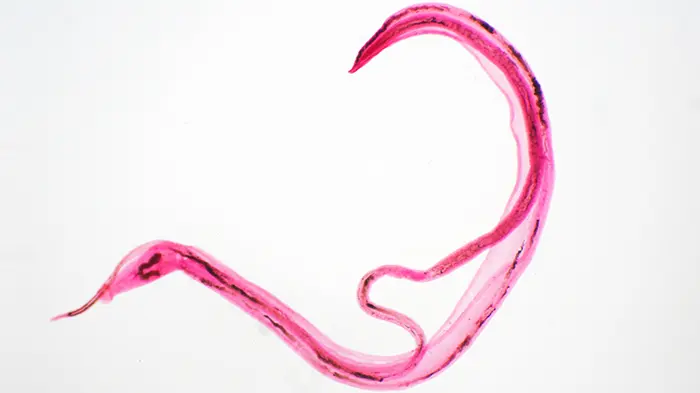
Dogs can only be infected with whipworms by ingesting the eggs from soil or other substrates containing eggs. In the small intestine, larvae hatch from ingested eggs and burrow into the mucosal lining. From 2 to 10 days later, they move on to the cecum and grow into adult worms.
The eggs are not immediately infectious when passed in feces. They need several weeks in soil to develop into infective larvae inside their shells. A dog eats contaminated soil or objects in the soil and the cycle of infection begins.
Adult whipworms look like tiny pieces of thread, with one end enlarged. They’re rarely seen in in feces. Many pets show no signs of illness with a whipworm infestation. Symptoms when they do occur can include bloody diarrhea, dehydration, weight loss, anemia and even death in severe cases.
Re-infection with whipworm from contaminated environments is a significant concern. The eggs are extremely resilient and resistant to most cleaning methods and even freezing temperatures. They can be dried out with strong agents like agricultural lime, but the preferred method is to replace contaminated soil with new soil or another substrate.
Regularly picking up poop from your yard and other areas your pet frequents will help reduce the risk of further contamination of soil.
How Do I Know If My Dog Has Worms?
It can be challenging to determine if your pet has worms. As noted above, some intestinal worms can be seen with the naked eye, when the worm burden gets high enough; others can’t. Generally speaking, dogs with worm infestations may have one or more of the following symptoms:
- Diarrhea that may or may not contain blood
- Vomiting
- Weight loss
- Poor coat condition
However, sometimes the presence of intestinal worms causes no noticeable symptoms. The worms can also lay dormant in your dog’s body for long periods. The most proactive way to assure your animal isn’t harboring internal parasites is to automatically check for them as a part of your pet’s annual wellness exam.
Diagnosis and Ridding Your Dog of Worms
As with any illness in your furry family member, the earlier the presence of intestinal worms is diagnosed and treated, the better the outcome.
Many veterinarians include a stool check as part of the wellness exam. If yours doesn’t, you can request it. Bring a dime-sized amount of fresh stool to your vet visit for this important screening test.
It’s important to note that tapeworms (and giardia) can be difficult to diagnose with routine stool sample tests, so be sure to keep an eye out for the appearance of “rice” either in your pet’s poop or in the fur around his rear end, or intermittent, unexplained mushy, soft poop.
It’s very important that your veterinarian identifies the precise type of worm present in your dog’s intestinal tract because there isn’t a universal dewormer that will kill all types of parasites. Don’t guess at what type of parasites might be present, because there’s no way to accurately assess a pet’s parasite status without testing.
“General dewormers” for roundworms are often included in heartworm medications prescribed for monthly use, resulting in unnecessary drug intake (if your dog doesn’t have roundworms), potential drug resistance, as a result of repeated unnecessary dewormings, and the false assumption that your pup must be parasite-free.
More is not better when it comes to deworming chemicals and your pet. If your dog has giardia, for example, treat the giardia specifically, and only long enough to clear the infection. Rechecking after treatment is imperative, to confirm the treatment worked.
However, providing a monthly wormer for roundworms if your pet doesn’t have roundworms only disrupts the microbiome unnecessarily, which can have unwanted long-term consequences.
Some supplement companies offer natural dewormers for certain kinds of intestinal worm infestations. I’ve tried them all and unfortunately, sometimes they reduce an animal’s parasite load, and sometimes they don't. It’s important to remember that reducing parasite load is entirely different than eliminating parasites altogether.
It's fine to try natural deworming first, but to make sure these resilient parasites are truly eliminated you must repeat fecal parasite testing several months in a row, regardless of what natural product you try, to avoid GI problems caused by chronic low-grade parasitism.
Probiotic supplements and foods should be used after natural and chemical deworming protocols to reseed the gut with the beneficial bacteria negatively impacted by both treatment options.











